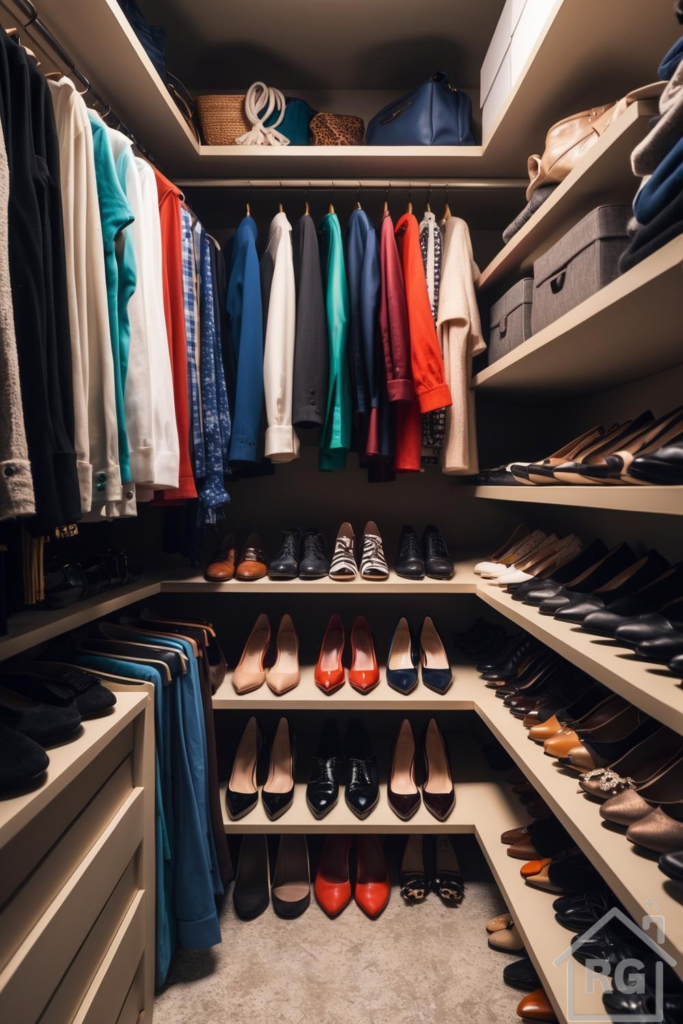
Unlock the Potential of Your Walk-In Closet
A walk-in closet is often a coveted feature in a home, promising ample space for clothes, shoes, and accessories. However, without a proper organization system, even the largest walk-in can quickly become a cluttered and stressful space. The key lies in strategic planning and utilizing every inch effectively, transforming it from a mere storage area into a functional and aesthetically pleasing personal boutique. This image showcases a beautifully organized closet, offering a blueprint for achieving closet nirvana. Let’s break down the elements that make this space work so well and how you can implement similar strategies in your own home.
1. Maximize Vertical Space with Smart Shelving
One of the most striking features of this closet is the extensive use of vertical shelving. From floor to near-ceiling, the shelves provide dedicated zones for different items. Notice how shoes are meticulously arranged on multiple tiers, making each pair visible and accessible. Upper shelves are perfect for less frequently used items like out-of-season clothing stored in bins, handbags, or decorative baskets. Using adjustable shelving allows for customization as your storage needs change.
Pro Tip: When planning shelving, measure the height of your typical items. Folded sweaters need a different height than shoe boxes or handbags. Consistent spacing creates a cleaner look, but prioritize functionality.
2. Optimize Hanging Space
Hanging space is crucial for items prone to wrinkling, like blouses, shirts, dresses, and jackets. This closet utilizes multiple hanging rods, potentially double-stacked in some areas (though not fully visible) to maximize vertical storage. Grouping similar items together (e.g., all shirts, all jackets) and arranging them by color not only looks visually appealing but also makes finding specific pieces much faster.
Pro Tip: Invest in uniform, slim hangers. Velvet or wooden hangers look cohesive and prevent clothes from slipping, unlike mismatched plastic or wire hangers which can create visual clutter and take up more space.
3. Dedicated Shoe Storage Solutions
Shoes can easily become a jumbled mess on the closet floor. This design dedicates significant shelving specifically for footwear. Arranging shoes neatly, often alternating heel-to-toe for pairs like pumps, maximizes shelf space and keeps them in good condition. Open shelving makes it easy to see your collection at a glance. For less frequently worn or delicate shoes, clear shoe boxes stacked on shelves offer protection from dust while still allowing visibility.
Pro Tip: Consider angled shoe shelves for heels or slanted shelves with a front lip to prevent shoes from sliding off, especially if space is tight.
4. Contain the Clutter: Bins and Baskets
Not everything can or should be hung or placed directly on a shelf. Storage bins and baskets are essential for corralling smaller items, accessories, or folded garments like t-shirts or sweaters if shelf space is preferred over drawers. In the example image, grey fabric bins sit neatly on the upper shelves, likely holding seasonal items or accessories. A woven basket adds a touch of natural texture while providing storage. Using opaque bins creates a cleaner, more uniform look, while clear bins allow you to see contents easily.
Pro Tip: Label your bins! Even if you think you’ll remember what’s inside, labels save time and prevent unnecessary rummaging.
5. Lighting Matters
Good lighting is often overlooked but is critical in a closet. This closet appears well-lit, likely with overhead or integrated shelf lighting, ensuring that even items tucked away in corners are visible. Proper lighting makes it easier to distinguish colors (no more grabbing the navy sweater instead of the black one!) and find what you need quickly. Consider LED strip lighting under shelves or puck lights for targeted illumination.
6. Regular Maintenance is Key
An organized closet doesn’t stay that way by magic. Schedule regular decluttering sessions (perhaps seasonally) to purge items you no longer wear or need. Follow the ‘one in, one out’ rule: when you buy a new item, donate or discard an old one. Take a few extra seconds each day to put items back in their designated spots – hang clothes properly, place shoes back on their shelf. This small daily effort prevents clutter from building up.
Creating Your Own Organized Oasis
Inspired by this example? Start by assessing your own closet and inventory. What types of items do you have the most of? What are your biggest clutter challenges? Measure your space and sketch out a potential layout incorporating shelves, rods, and potentially drawers or bins. Don’t be afraid to start small – even organizing one section, like your shoes or sweaters, can make a big difference and motivate you to tackle the rest. With thoughtful planning and consistent habits, you can transform your walk-in closet into a functional, beautiful, and stress-free space.
